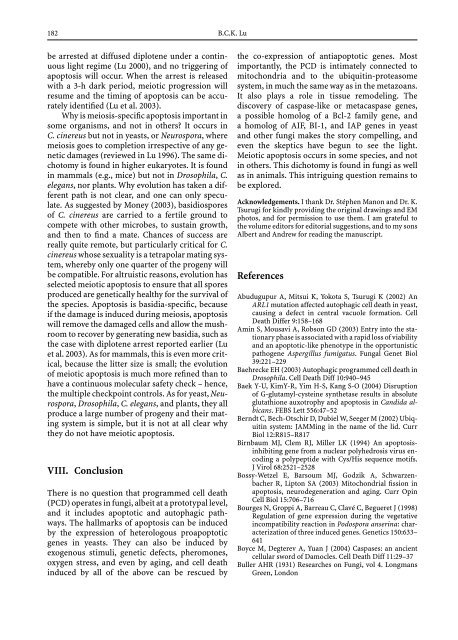Growth, Differentiation and Sexuality
Growth, Differentiation and Sexuality
Growth, Differentiation and Sexuality
You also want an ePaper? Increase the reach of your titles
YUMPU automatically turns print PDFs into web optimized ePapers that Google loves.
182 B.C.K. Lu<br />
be arrested at diffused diplotene under a continuous<br />
light regime (Lu 2000), <strong>and</strong> no triggering of<br />
apoptosis will occur. When the arrest is released<br />
with a 3-h dark period, meiotic progression will<br />
resume <strong>and</strong> the timing of apoptosis can be accurately<br />
identified (Lu et al. 2003).<br />
Why is meiosis-specific apoptosis important in<br />
some organisms, <strong>and</strong> not in others? It occurs in<br />
C. cinereus but not in yeasts, or Neurospora,where<br />
meiosisgoestocompletionirrespectiveofanygenetic<br />
damages (reviewed in Lu 1996). The same dichotomy<br />
is found in higher eukaryotes. It is found<br />
in mammals (e.g., mice) but not in Drosophila, C.<br />
elegans, nor plants. Why evolution has taken a different<br />
path is not clear, <strong>and</strong> one can only speculate.<br />
As suggested by Money (2003), basidiospores<br />
of C. cinereus are carried to a fertile ground to<br />
competewithothermicrobes,tosustaingrowth,<br />
<strong>and</strong> then to find a mate. Chances of success are<br />
really quite remote, but particularly critical for C.<br />
cinereus whose sexuality is a tetrapolar mating system,<br />
whereby only one quarter of the progeny will<br />
be compatible. For altruistic reasons, evolution has<br />
selected meiotic apoptosis to ensure that all spores<br />
produced are genetically healthy for the survival of<br />
the species. Apoptosis is basidia-specific, because<br />
if the damage is induced during meiosis, apoptosis<br />
will remove the damaged cells <strong>and</strong> allow the mushroom<br />
to recover by generating new basidia, such as<br />
the case with diplotene arrest reported earlier (Lu<br />
et al. 2003). As for mammals, this is even more critical,<br />
because the litter size is small; the evolution<br />
of meiotic apoptosis is much more refined than to<br />
have a continuous molecular safety check – hence,<br />
the multiple checkpoint controls. As for yeast, Neurospora,<br />
Drosophila, C. elegans, <strong>and</strong> plants, they all<br />
producealargenumberofprogeny<strong>and</strong>theirmating<br />
system is simple, but it is not at all clear why<br />
they do not have meiotic apoptosis.<br />
VIII. Conclusion<br />
There is no question that programmed cell death<br />
(PCD) operates in fungi, albeit at a prototypal level,<br />
<strong>and</strong> it includes apoptotic <strong>and</strong> autophagic pathways.<br />
The hallmarks of apoptosis can be induced<br />
by the expression of heterologous proapoptotic<br />
genes in yeasts. They can also be induced by<br />
exogenous stimuli, genetic defects, pheromones,<br />
oxygen stress, <strong>and</strong> even by aging, <strong>and</strong> cell death<br />
inducedbyalloftheabovecanberescuedby<br />
the co-expression of antiapoptotic genes. Most<br />
importantly, the PCD is intimately connected to<br />
mitochondria <strong>and</strong> to the ubiquitin-proteasome<br />
system, in much the same way as in the metazoans.<br />
It also plays a role in tissue remodeling. The<br />
discovery of caspase-like or metacaspase genes,<br />
a possible homolog of a Bcl-2 family gene, <strong>and</strong><br />
a homolog of AIF, BI-1, <strong>and</strong> IAP genes in yeast<br />
<strong>and</strong> other fungi makes the story compelling, <strong>and</strong><br />
even the skeptics have begun to see the light.<br />
Meiotic apoptosis occurs in some species, <strong>and</strong> not<br />
in others. This dichotomy is found in fungi as well<br />
as in animals. This intriguing question remains to<br />
be explored.<br />
Acknowledgements. I thank Dr. Stéphen Manon <strong>and</strong> Dr. K.<br />
Tsurugi for kindly providing the original drawings <strong>and</strong> EM<br />
photos, <strong>and</strong> for permission to use them. I am grateful to<br />
the volume editors for editorial suggestions, <strong>and</strong> to my sons<br />
Albert <strong>and</strong> Andrew for reading the manuscript.<br />
References<br />
Abudugupur A, Mitsui K, Yokota S, Tsurugi K (2002) An<br />
ARL1 mutation affected autophagic cell death in yeast,<br />
causing a defect in central vacuole formation. Cell<br />
Death Differ 9:158–168<br />
Amin S, Mousavi A, Robson GD (2003) Entry into the stationary<br />
phase is associated with a rapid loss of viability<br />
<strong>and</strong> an apoptotic-like phenotype in the opportunistic<br />
pathogene Aspergillus fumigatus. Fungal Genet Biol<br />
39:221–229<br />
Baehrecke EH (2003) Autophagic programmed cell death in<br />
Drosophila. Cell Death Diff 10:940–945<br />
Baek Y-U, KimY-R, Yim H-S, Kang S-O (2004) Disruption<br />
of G-glutamyl-cysteine synthetase results in absolute<br />
glutathione auxotrophy <strong>and</strong> apoptosis in C<strong>and</strong>ida albicans.<br />
FEBS Lett 556:47–52<br />
Berndt C, Bech-Otschir D, Dubiel W, Seeger M (2002) Ubiquitinsystem:JAMMinginthenameofthelid.Curr<br />
Biol 12:R815–R817<br />
Birnbaum MJ, Clem RJ, Miller LK (1994) An apoptosisinhibiting<br />
gene from a nuclear polyhedrosis virus encoding<br />
a polypeptide with Cys/His sequence motifs.<br />
J Virol 68:2521–2528<br />
Bossy-Wetzel E, Barsoum MJ, Godzik A, Schwarzenbacher<br />
R, Lipton SA (2003) Mitochondrial fission in<br />
apoptosis, neurodegeneration <strong>and</strong> aging. Curr Opin<br />
Cell Biol 15:706–716<br />
Bourges N, Groppi A, Barreau C, Clavé C, Begueret J (1998)<br />
Regulation of gene expression during the vegetative<br />
incompatibility reaction in Podospora anserina: characterization<br />
of three induced genes. Genetics 150:633–<br />
641<br />
Boyce M, Degterev A, Yuan J (2004) Caspases: an ancient<br />
cellular sword of Damocles. Cell Death Diff 11:29–37<br />
Buller AHR (1931) Researches on Fungi, vol 4. Longmans<br />
Green, London

















